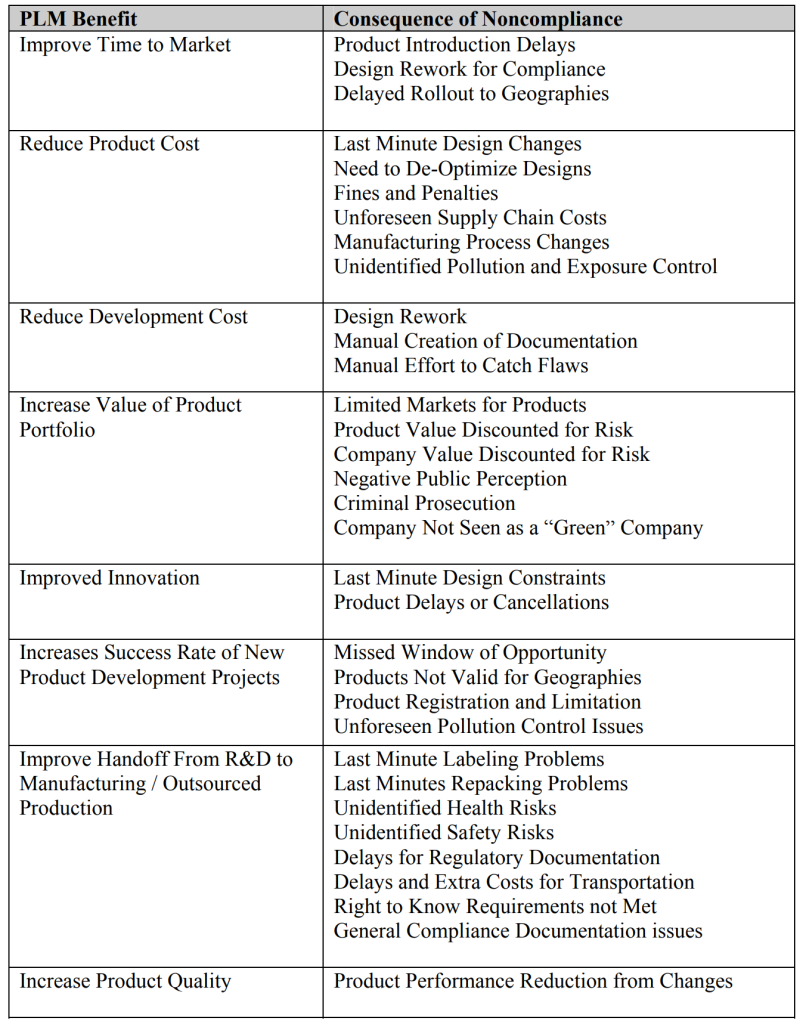Why compliance matters
Compliance is more than paperwork – it’s a core element of responsible, sustainable business. Noncompliance can lead to fines, penalties, lawsuits, and reputational damage that harm financial performance. Many regulations also aim to promote ethical behavior; following them builds trust with customers and stakeholders, which is increasingly important in the age of social media and instant communication.
Accordingly, compliance also improves risk management by helping organizations anticipate regulatory changes and reduce the impact of sudden disruptions. Embracing regulatory-compliant design can even be a competitive advantage: companies that prioritize accountability and transparency are often more attractive to investors and customers.
Compliance across the product lifecycle
Companies must maintain alignment with government requirements and internal policies throughout the entire product lifecycle. Without a robust compliance plan, the value proposition of Product Lifecycle Management (PLM) is at risk. Speed to market is a strategic priority for many companies; they compress development timelines, streamline supply chains, and accelerate commercialization to launch products ahead of competitors. But compliance is critical to that goal. If regulatory requirements aren’t considered from the start, teams may lose time on costly redesigns or reformulations later. This problem is especially common when entering new markets, where rules and authorities vary by jurisdiction. If designers lack visibility into final markets, restricted substances or noncompliant features can slip into the design and force major rework. These late discoveries can cost time, money, and competitive positioning. Regulatory-compliant design reduces that exposure.
Cost control and PLM benefits
One major aim of PLM programs is to reduce product and formula costs by controlling internal and supply‑chain expenses early in development. Lower costs can improve margins or enable lower customer prices. But compliance remains essential: if a product violates regulations, it may require post‑launch modifications or create ongoing cost burdens – for pollution control systems, protective packaging, special storage, or waste handling. Once a product is released, design flexibility falls sharply. Addressing compliance issues earlier preserves options to optimize costs; delaying increases both constraints and expenses. These costs go beyond parts and ingredients – higher handling, logistics, production, and regulatory fines can erode the benefits of a low‑cost design. Regulatory-compliant design helps prevent those late‑stage losses.

Figure 1. Consequence of Noncompliance on PLM. Value Source: Tech Clarity
Contact us today to learn how LA NPDT can assist in realizing your project.
Embedding Regulatory-compliant design
Experience shows that eliminating process defects raises quality – the principle behind Total Quality Management, Six Sigma, and similar programs. The design process can be improved the same way to avoid regulatory crises. Compliance issues should be treated as design process failures, whether they arise from physical design choices or commercial decisions. Compliance must be a mandated outcome of design work. To do that, regulatory requirements need to be identified and addressed as early as possible. In gated development processes, compliance checks should be part of every gate, starting with conceptual design before R&D begins. A thorough market review must clarify intended product use and the geographies where the product will be sold; those constraints are essential inputs to design.
Tools and automation for designers
When designers are given clear constraints, the next challenge is providing the right tools to detect violations of those constraints. The rules are too numerous and change too quickly for manual management. Designers need automated tools that check designs and flag potential regulatory issues early. The ideal capability provides instant visibility into how a design affects labeling, logistics, and regulatory compliance. Regulatory‑Compliant Design is built around that logic.

Figure 2. The Product Compliance lifecycle
Managing compliance effectively requires tools and updated regulatory rules
Handling compliance efficiently means giving designers tools that simplify complexity and supplying a reliable, up‑to‑date source of regulatory content expressed as enforceable rules. Some companies build these capabilities in‑house, but off‑the‑shelf solutions and specialist services are also available.
Adapting to digital standards and data privacy
As organizations become more digital and connected, robust frameworks for quality, security, and privacy are essential. ISO standards and privacy laws like the GDPR offer structured guidance to help organizations stay compliant, protect stakeholders, and strengthen operational integrity. Below is a summary of the most relevant ISO standards and major privacy regimes, and their practical value.
1. Key ISO standards
- ISO 9001 – Quality Management System Purpose: Establishes a consistent method for delivering products and services that meet customer expectations and applicable regulatory requirements.
- ISO 27001 – Information Security Management System Purpose: Provides a systematic approach to protect sensitive information and reduce information security risk via a controlled management system.
- ISO 27701 – Privacy Information Management System Purpose: Extends ISO 27001 with privacy controls to help organizations comply with global privacy laws such as the GDPR.
- ISO 22301 – Business Continuity Management System Purpose: Helps maintain critical operations during disruptions like cyber incidents, natural disasters, or pandemics.
2. Global privacy frameworks: Protecting personal data is central to responsible digital business. Regional and global privacy laws support individuals’ rights and maintain trust in the data economy.
- GDPR (EU) – Broadly applies to organizations processing EU personal data; it gives individuals greater control over how their data is used and stored.
- CCPA (California) – Expands data rights for California residents, emphasizing transparency, access, and deletion.
- PIPEDA (Canada) – Governs how private sector organizations collect, use, and disclose personal data.
- HIPAA (U.S.) – Regulates protections for protected health information in the U.S. health sector.
- DPDPA (India) – Regulates the processing of digital personal data and protects privacy rights in India.
Future direction: agility, tech, and global alignment
Regulatory and technological landscapes are evolving rapidly, so compliance systems must be continuously reviewed and strengthened. Three trends will shape the future of ISO and privacy compliance:
- Agility: Compliance frameworks need flexible architectures that can be updated quickly as standards and laws change.
- Advanced technology: AI, automation, and analytics will play a central role in real‑time compliance, risk monitoring, consent management, and incident response.
- Global alignment: With growing cross‑border data flows, organizations must handle multiple rule sets–aligning international ISO standards with regional privacy laws.
These forward‑looking strategies build resilience, enable innovation, and foster trust. Preparing for regulatory change not only ensures alignment, it creates a foundation for sustainable, secure, and transparent operations.
The Impact of Noncompliance
Noncompliance can have far‑reaching consequences that go well beyond immediate penalties. Serious compliance failures can alter strategy, hinder market entry, and damage brand positioning. Key impacts include:
- Financial: The most direct effects are monetary – fines, higher operating costs, product waste, costly corrective actions, and relabeling or recalls can run into millions. Downstream losses include reduced sales, lost contracts, and refunds.
- Reputational: Financial losses can sometimes be insured, but reputational damage is harder to quantify and longer lasting. Reputation hits are especially severe in sectors like food and beverage, healthcare, and pharmaceuticals, where noncompliance can endanger consumers.
- Strategic and operational: Compliance is a strategic asset, not just an expense. Without it, scaling and sustainable growth become difficult. Noncompliance can trigger customer churn, lost revenue, increased regulatory scrutiny, product launch delays, and reduced attractiveness to investors and partners. Regulatory-compliant design helps prevent this downward spiral.
Practical Guidelines for Regulatory-compliant design
- Build regulatory requirements into design work from the outset to identify constraints early.
- Monitor rule changes proactively for active products.
- Consider outsourcing rule maintenance to scale expertise.
- Embed compliance in lifecycle workflows and supporting technologies to eliminate inconsistent treatment.
- Treat compliance as responsible corporate behavior and a strategic investment, not an obstacle.
- Reduce complexity by partnering with technology providers that supply tools with integrated regulatory data.
- Manage compliance globally, covering multiple jurisdictions and languages.
- Ensure design teams have documented access to relevant rule content.
- Capture, store, and share critical data such as national inventories, exposure limits, and lists of banned or controlled substances.
Main Barriers to Effective Compliance
- Constant changes across global supply chains create a moving target of rules that partners and suppliers must absorb before they take effect. Proactive strategies are required.
- Poor data quality, inconsistent standards, manual processes, and system gaps lead to repeated errors and missed deadlines.
- Weak traceability makes it difficult to follow product lifecycle data from raw materials to finished goods. Regulatory-compliant design reduces this risk.



